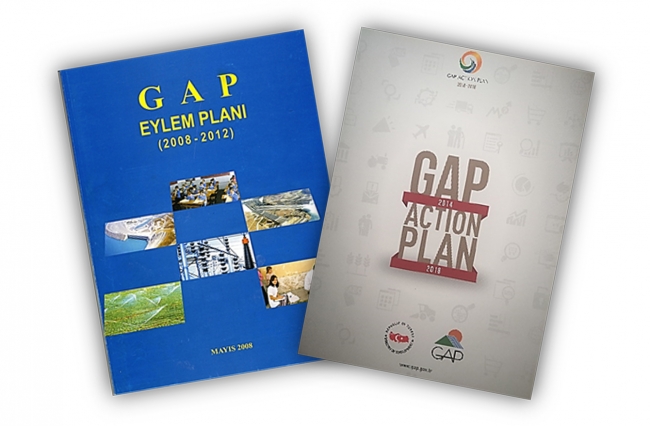
(2014-2018)
The South-eastern Anatolia Project (GAP) is a significant regional development programme that exhibits the regional potential of Turkey and contributes to national economy in real terms with welfare it brings along. It is a project that sets local initiatives in motion and it has attainable targets. The GAP is the largest project ever in Turkey and also one of the largest throughout the world. As such, it is the indicator of determinedness to walk ahead in unity and openness to further development.
| GAP ACTION PLAN (2014-2018) |
(2008-2012)
With the GAP Action Plan (2008-2012) all investments and experiences that far were gone over in order to accelerate investments under the South-eastern Anatolia Project (GAP) and to have most of them completed by the end of 2012. This vision was for economic growth, social development and employment generation and thus for the welfare and happiness of the people in the region. The acceleration step prioritized basic infrastructure investments including those related to irrigation in the first place.
| GAP ACTION PLAN (2008-2012) |
In the GAP Action Plan there are four development axes and 73 major actions under these axes. There are over 300 individual projects and activities under major actions. Four strategic axes are:
- Economic Development,
- Social Development,
- Infrastructure Building, and
- Institutional Capacity Building.
1. Economic Development
In the field of economic development, the priority targets of interventions to be made through the Action Plan include the following: employment creation; promoting those lines of production with high value added; diversification of production; facilitation of integration with national and international markets; creating a positive brand image for goods and services of the region and supporting agro-industries and tourism in particular in line with the existing potential of the region.
While extending support to these initiatives, the primary consideration will be selecting spatial focuses that would ensure highest returns in terms of efficiency, interaction and coordination. This, in turn, will entail the creation city-based regional and national centres of attraction so as to accelerate the process of development.
Also planned are reshaping of incentive policies in line with potentials in the region; expanding the scope and improving the quality of SMSE (small and medium size enterprise) support and promotion of techno-parks particularly in universities with well-developed infrastructure.
The GAP Region is endowed with rich natural and cultural properties, historical sites and special protection areas. There is need to make improvements in tourism infrastructure in order to contribute to employment and socioeconomic development by utilizing this potential for purposes of tourism.
The region has its comparative advantage in the sector of agriculture. It is thus planned to support investments in this sector, encourage agricultural organizations including cooperatives and to promote organic farming activities. Also, weight is given to rural development programmes and associated activities in order to make use of existing potential in rural sector and improve rural living standards.
2. Social Development
With respect to regional development, there is need to improve indicators in such areas as health, education, employment and social protection which presently lag behind national averages, increase individual and community participation to economic and social life and ensure higher life quality and social cohesion along with economic growth.
The Plan provides for equal opportunities, higher rates of school enrolment and bringing down the number of pupils per class to national averages by improving access to education, improving its quality as well as physical and human infrastructure, including in higher education.
For improving health services, there will be transition to quality room and ward system in hospitals and the number of beds per 10 000 people will be brought up to 20.
In the context of preventive health services, the system of family medicine will be adopted in all provinces of the region.
For promoting employment, reducing unemployment and informal employment, improving the qualification of labour force and ensuring social integration, the basic principle adopted is to provide training and counselling services aiming at building skills, facilitating participation to labour force and presenting self-employment opportunities especially for vulnerable and disadvantaged population groups including women and youth.
In the field of arts, culture and sports, the objective is to provide new facilities and improve existing ones in the region and to ensure the easy access of all groups to such facilities.
One programme which will be launched for the first time in the GAP Region under the GAP Action Plan is the Social Support Programme (SODES). The primary objective of this programme is to strengthen human capital in the region and to support the process of social cohesion. Implemented at local scale, SODES projects envisage the following: improving employability; ensuring wider and more active participation of disadvantaged groups to social and economic life and helping youth and women in the region express themselves better through cultural, artistic and sportive activities.
3. Infrastructure Building
Providing quality and sufficient infrastructure services is the determining factor in materializing economic transformation and accelerating social progress. The priority target in the GAP is the completion of irrigation infrastructure so as to ensure economic returns to land and water resources in which the region has its comparative advantage.
The GAP Irrigation Programme aims at completing those gravity irrigation projects whose water resources and design are ready and main canals are under construction as well as GAP as well as first level pumped irrigation projects that are deemed as economic. The region has about 1.8 million hectares of irrigable land and the plan envisages the completion of irrigation projects on 1 060 000 hectares of land by the end of 2012.
For the economic and social development of the region, the plan also contains other actions including improvements in natural gas and electricity transmission infrastructure and completion of Ilısu Dam as one of the biggest facilities of the GAP.
In the field of land transportation, the plan includes Gaziantep-Şanlıurfa motorway; multi-lane roads in main arteries including Şanlıurfa-Diyarbakır, Şanlıurfa- Kızıltepe- Silopi, Şanlıurfa-Akçakale, Diyarbakır-Batman, and Diyarbakır-Mardin; all geared to breaking through transportation bottlenecks as required by emerging economic activities. There is also the target of improving air transportation infrastructure, which is quite important for the region, with due consideration of international connections.
Other plan targets include the following: Strengthening OIZs, SISs and other industrial and commercial infrastructure; building infrastructure to facilitate border trade; providing for housing needs; improving building quality at urban centres; drinking water supply and improving infrastructure for solid waste and wastewater management.
4. Building Institutional Capacity
For effective planning, implementation, monitoring and evaluation of all activities and projects in the region, there is need to support both central and local/regional agencies in their efforts to build capacity including in the field of human resources.
In this context it is envisaged that development agencies should be established and start operating as soon as possible in level 2 regions that comprise the whole region: Gaziantep (Adıyaman, Gaziantep, Kilis), Mardin (Batman, Mardin, Siirt, Şırnak) and Şanlıurfa (Diyarbakır, Şanlıurfa).
Actions under this axis include the following: Providing necessary funds and means to local governments in the region in the field of development initiatives and service delivery; supporting the private sector, professional organizations and civil society organizations engaged in development activities; facilitating their cooperation among themselves and with governmental agencies and strengthening social-institutional capital in the region.

















